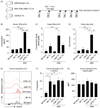Basophil responses in susceptible AKR mice upon infection with the intestinal helminth parasite Trichuris muris
- PMID: 37415265
- PMCID: PMC10513073
- DOI: 10.1111/pim.12999
Basophil responses in susceptible AKR mice upon infection with the intestinal helminth parasite Trichuris muris
Abstract
Intestinal helminth infection promotes a Type 2 inflammatory response in resistant C57BL/6 mice that is essential for worm clearance. The study of inbred mouse strains has revealed factors that are critical for parasite resistance and delineated the role of Type 1 versus Type 2 immune responses in worm clearance. In C57BL/6 mice, basophils are key innate immune cells that promote Type 2 inflammation and are programmed via the Notch signalling pathway during infection with the helminth Trichuris muris. However, how the host genetic background influences basophil responses and basophil expression of Notch receptors remains unclear. Here we use genetically susceptible inbred AKR/J mice that have a Type 1-skewed immune response during T. muris infection to investigate basophil responses in a susceptible host. Basophil population expansion occurred in AKR/J mice even in the absence of fulminant Type 2 inflammation during T. muris infection. However, basophils in AKR/J mice did not robustly upregulate expression of the Notch2 receptor in response to infection as occurred in C57BL/6 mice. Blockade of the Type 1 cytokine interferon-γ in infected AKR/J mice was not sufficient to elicit infection-induced basophil expression of the Notch2 receptor. These data suggest that the host genetic background, outside of the Type 1 skew, is important in regulating basophil responses during T. muris infection in susceptible AKR/J mice.
Keywords: AKR-inbred strain; Trichuris muris; Type 2 inflammation; basophils; notch signalling.
© 2023 John Wiley & Sons Ltd.
Figures




Similar articles
-
Notch-activated basophils support intestinal CD4+ T cell fate and function during Trichuris muris infection.Mucosal Immunol. 2025 Aug;18(4):937-950. doi: 10.1016/j.mucimm.2025.05.004. Epub 2025 May 16. Mucosal Immunol. 2025. PMID: 40383395
-
The Notch signaling pathway promotes basophil responses during helminth-induced type 2 inflammation.J Exp Med. 2019 Jun 3;216(6):1268-1279. doi: 10.1084/jem.20180131. Epub 2019 Apr 11. J Exp Med. 2019. PMID: 30975892 Free PMC article.
-
Isolates of Trichuris muris elicit different adaptive immune responses in their murine host.Parasite Immunol. 2005 Mar;27(3):69-78. doi: 10.1111/j.1365-3024.2005.00746.x. Parasite Immunol. 2005. PMID: 15882233
-
Trichuris muris Model: Role in Understanding Intestinal Immune Response, Inflammation and Host Defense.Pathogens. 2021 Jul 22;10(8):925. doi: 10.3390/pathogens10080925. Pathogens. 2021. PMID: 34451389 Free PMC article. Review.
-
Another decade of Trichuris muris research: An update and application of key discoveries.Adv Parasitol. 2023;121:1-63. doi: 10.1016/bs.apar.2023.05.002. Epub 2023 Jul 6. Adv Parasitol. 2023. PMID: 37474238 Review.
Cited by
-
Anti-Inflammatory Effects of Helminth-Derived Products: Potential Applications and Challenges in Diabetes Mellitus Management.J Inflamm Res. 2024 Dec 28;17:11789-11812. doi: 10.2147/JIR.S493374. eCollection 2024. J Inflamm Res. 2024. PMID: 39749005 Free PMC article. Review.
References
Publication types
MeSH terms
Substances
Grants and funding
LinkOut - more resources
Full Text Sources
Miscellaneous

